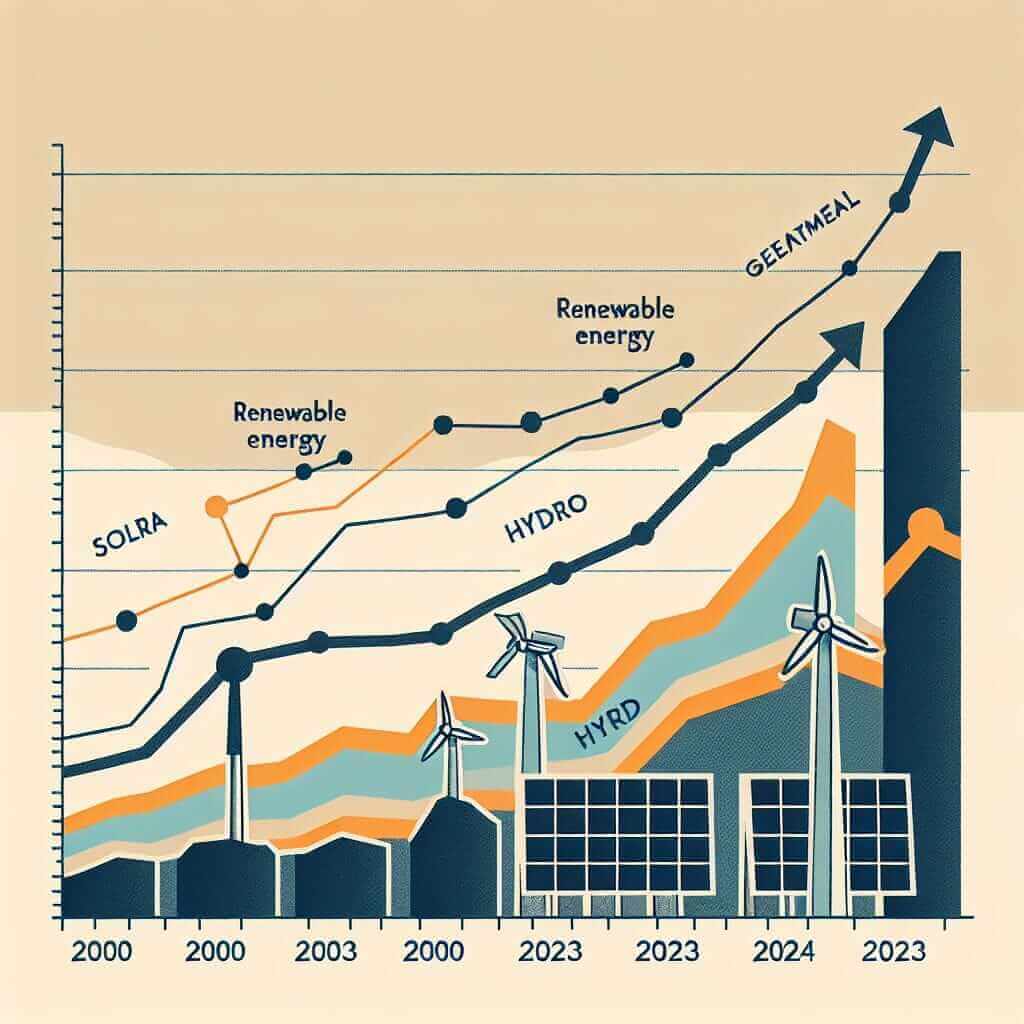The International English Language Testing System (IELTS) often includes topics from real-world issues in its Writing Task 1. One common topic is “Trends in Renewable Energy Consumption Rates.” This topic not only tests your ability to interpret and summarize data but also your general understanding of renewable energy trends. Let’s analyze the trends in renewable energy consumption from 2000 to 2023 and how you should approach this type of task in the IELTS Writing Task 1.
Introduction
Interpreting data related to “Trends in Renewable Energy Consumption Rates (2000-2023)” has appeared frequently in IELTS tests. Here are a couple of sample topics related to this area:
- Sample Task 1: The line graph shows the consumption rates of different types of renewable energy sources from 2000 to 2023. Summarize the information by selecting and reporting the main features and make comparisons where relevant.
- Sample Task 2: The bar chart illustrates the growth in the consumption of solar and wind energy in five different countries over a period from 2000 to 2023. Summarize the information by selecting and reporting the main features and make comparisons where relevant.
Choose a Task and Present the Data
For this lesson, we will choose Sample Task 1 and create a line graph to base our practice on.

Analyzing the Task
Understanding the task is vital. You need to:
- Identify the main features: Find the key trends and changes over the period.
- Make comparisons: Note any significant similarities or differences between the data points.
- Summarize concisely: Describe the trends and comparisons clearly and concisely.
Writing Sample
Here is a sample answer for the chosen task:
Sample Answer
The line graph illustrates the consumption rates of different types of renewable energy, namely solar, wind, hydro, and geothermal, from 2000 to 2023.
Overall, the consumption of all types of renewable energy increased over the given period, with solar energy showing the most significant rise. In 2000, hydro energy was the most consumed source, at approximately 10 GW (gigawatts), followed closely by geothermal energy at around 9 GW. Wind and solar energy had the lowest consumption rates, both below 4 GW.
From 2000 to 2010, hydro and geothermal energy consumption remained relatively stable, fluctuating around their initial values. In contrast, wind and solar energy consumption started to rise gradually, surpassing 6 GW by 2010.
The period from 2010 to 2023 saw a marked increase in the consumption of renewable energies, particularly solar and wind. Solar energy consumption skyrocketed to nearly 25 GW by 2023, making it the most consumed renewable energy source by the end of the period. Wind energy also saw a substantial rise, reaching approximately 20 GW.
Hydro and geothermal energy consumption increased at a slower pace, with hydro energy reaching around 15 GW and geothermal energy about 13 GW by 2023.
In summary, while hydro and geothermal energy consumption showed moderate growth, solar and wind energy consumption experienced exponential increases, highlighting a significant shift towards these renewable sources over the past two decades.
Word Count: 227
Writing Tips
When writing about trends in renewable energy consumption, consider the following vocabulary and grammatical structures:
Vocabulary:
- Consumption (n.) /kənˈsʌmp.ʃən/ – The amount of energy used.
- Fluctuate (v.) /ˈflʌk.tʃu.eɪt/ – To change continuously.
- Significant (adj.) /sɪɡˈnɪf.ɪ.kənt/ – Important; notable.
- Marked (adj.) /mɑːrkt/ – Clearly noticeable; evident.
- Skyrocket (v.) /ˈskaɪˌrɒk.ɪt/ – To increase rapidly.
- Moderate (adj.) /ˈmɒd.ər.ət/ – Average in degree; not extreme.
- Exponential (adj.) /ˌek.spəˈnen.ʃəl/ – Becoming more rapid.
Grammar Tips:
- Comparative Structures: Use comparative forms to show differences (e.g., “more significant than,” “higher than”).
- Present Perfect Tense: For trends starting in the past and continuing to the present (e.g., “has increased”).
- Passive Voice: When the subject performing the action is not as important (e.g., “was consumed by”).
Conclusion
Approaching IELT Writing Task 1 questions about data trends involves identifying main features, making key comparisons, and summarizing concisely. Focus on using precise vocabulary and appropriate grammatical structures to convey information accurately. With practice and attention to detail, achieving a high band score is within your reach.
Happy studying and best of luck in your IELTS preparation!